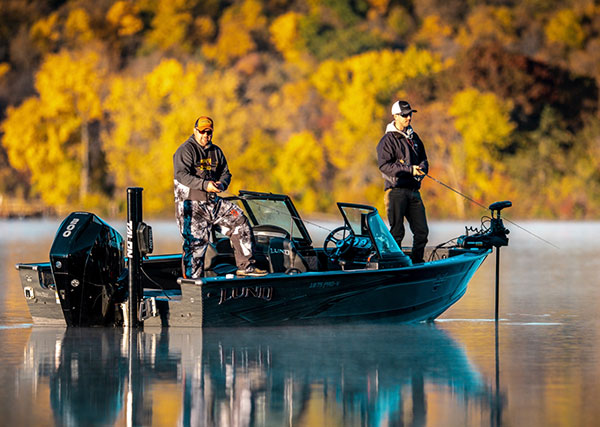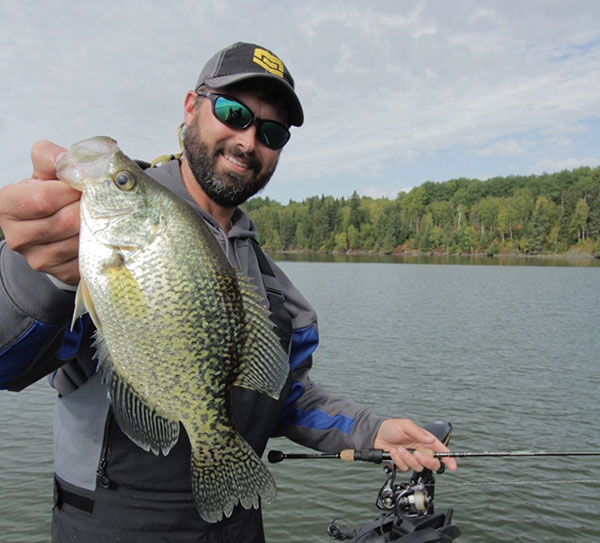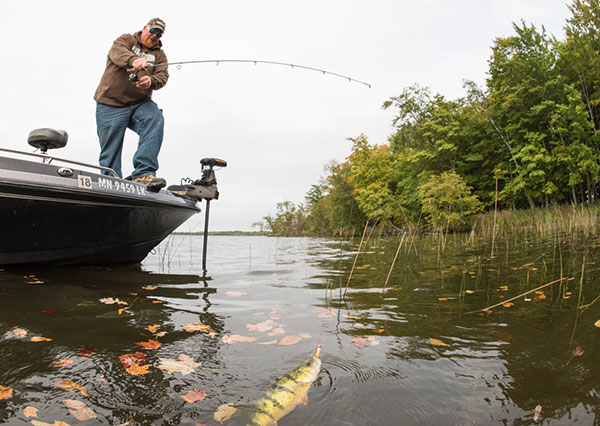By Josh Lantz
(For St. Croix Rods)
Whether targeted for fun or for the table, panfish please most anglers– especially lunker crappies and hand-sized bull bluegills. Fall is a great time to catch them, but with variables like changing vegetation, cooling weather, turnover, and fall bait migrations, how do you crack the code for consistent success?
We asked four of the nation’s top panfish specialists five questions about fall crappie and bluegill fishing. Their answers will help anyone become a more successful fall panfish angler.
 Joel Nelson
Joel Nelson
Q1 - What factors are influencing where and how you are fishing panfish right now and throughout the fall?
Joel Nelson – As lakes turn over and water temperatures no longer restrict their depths, you’ll see bait moving shallower to seek out cover for protection. I’ll typically find big crappies and even bluegills following them up on any available cover or structure – especially rocks with nearby wood.
Jeremy Smith – Weather is the primary factor influencing where I’ll target fall panfish. Deep bites in fall tend to be the most consistent. From my experience, it’s easier to find fish in deeper water basin areas and get them to bite when the weather is nasty. On warm, pleasant fall days, however, shallower fish relating to weeds, cribs, or other cover aren’t buried in as far and can be easier to find and catch. If there is good weed cover, meaning vertical standing weeds, all fish – including panfish – will use them throughout the fall and into winter. I’ve found a number of great panfish spots on accident while bass fishing that are far shallower than I thought panfish would be in the fall… dense weeds in five-to-eight-feet of water. It’s no secret, fish love weeds and if you find good weeds in the fall, chances are bluegills and crappies will be using them for as long as they are green and standing, sometimes all the way ‘til first ice.
Blake Tollefson – I spend the majority of my time on small lakes, like 200 acres or less. Dropping water temperatures and weed die offs are the biggest factors with the most significant impacts on where and how I’ll target panfish throughout the fall. As long as standing, green weeds are available, panfish will be there.
Brian “Bro” Brosdahl – Warmer waters in many areas this year – definitely including my stomping grounds in Northern Minnesota – have created some atypical behavior in crappies. Many absorbed their spawn this spring and they’ve stayed inside the shallow weed beds all summer – never moving out into the basins. They are largely still lingering on the outer edges of green weed edges.
 Jeremy Smith
Jeremy Smith
Q2 - What are the best panfish opportunities in terms of general locations and species right now?
Joel – Crappies in my mind hunt bait more aggressively, and I think are therefore easier to pattern. Gills are more opportunists that’ll eat anything, so they can be deeper to shallower, on weed edges, and generally more spread out.
Jeremy – As I said, the easiest bite for fall panfish is usually for suspended fish in deep water… water from 20-25 feet. This is primarily crappies, but bluegills can use these locations too. These areas are easy to spot on a map, and the fish light up on electronics. If the fish are deeper than 25’, please look at this as a harvest opportunity. There is a lot of mortality from barotrauma caused by catching crappies from deep water. Keep what you catch even when they are small, because they likely won’t survive. If you sit on these deep schools catching them one after the other and release them, you’re doing a lot of harm.
Blake – The majority of my focus is on crappies, which school up more heavily than normal in the Fall. Fall crappies tend to relate to deep weed lines and wood (submerged timber and cribs). In lakes that have wood, this seems to hold the largest numbers of fish. As the season progresses, a lot of crappies will push out to the basin, which is where fish will stay for a good portion of the winter, especially in lakes that don't have healthy weeds. Healthy weeds will always hold fish. In the fall, I like to think about where crappies are in the summer and where they are in the winter, then I usually start my search somewhere in between.
Bro – Crappies and bluegills along green weed edges, shoreline brush, and cribs.
 Blake Tollefson
Blake Tollefson
Q3 – What techniques, presentations, and gear are you using to earn success with these opportunities?
Joel –St. Croix’s Legend Elite Panfish Series provides incredible performance for the money. A model like the 6’9” ultralight power, fast action PFS69ULF pairs well with pitching 1/32-to-3/16-ounce jig-and-plastic combinations to the edges of cover, which I’m doing a lot of right now. I also do a fair amount of jig trolling and trolling of lipless cranks, too. This is really just covering water to help me find shorelines I should be focusing on. For this work, I usually use a rod with a light or even a medium-light power, which does well pulling baits like lipless cranks that have more resistance coming through the water. A lot of times, I’ll use this searching technique during the day, then I’ll come back during the primetime morning or dusk hours and dissect the cover in these areas by pitching jigs.
Jeremy – There are so many variables to fall panfish presentations. In deep water, a Jigging Rap is really tough to beat, but a drop shot is also extremely effective, especially if I’m looking for deep, weed line fish. Drop shots get down quickly and keep the bait in the zone. If crappies are the primary target I’ll use plastic, and the Big Bite Crappie Minnr is my go-to. If I’m looking for gills, I’ll have bait – angle worms and wax worms. If the fish are shallower or up in the water column, a size-4 or -6 X Rap has quickly become one of the most impressive presentations I’ve found for crappies. I thought it was more of a spring thing but have figured out that crappies lose their mind for it any time they are shallow enough to present it to them. Unlike carrying 20 rods to go bass fishing, I only carry a couple for panfish. I love the 7’ light, extra fast in St. Croix’s Panfish and Legend Elite Panfish series, and pair it with a size 1000 Daiwa Fuego LT spinning reel and six-pound braid. This rod can do everything for panfish. I’ll use it for deep-water size-3 Jigging Rap fishing, pitching and swimming jigs, drop shotting, and fishing small jerkbaits.
Blake – When fishing close to cover, like cribs, I rely primarily on shorter rods for vertical jigging. A rod like St. Croix’s 5’6” ultralight, fast action Legend Elite Panfish (LEP56ULF) is a joy to present light, 1/32-to-1/8-ounce jig and plastic combinations on, including those incorporating my favorite Eurotackle Fat Assassins and Eurogrubs. For heavier baits like small Jigging Raps and Eurotackle Z-Vibers, I’ll move up to any 5’6” to 6’6” light power, fast or extra-fast action spinning rod from St. Croix. I also like to dropshot for fall crappies when they relate to cribs and wood. The LEP70LXF – also available in the Panfish Series – is my favorite panfish dropshot rod. Size 6 or 8 VMC Spin Shot hooks tipped with a soft plastic and terminated with a 1/8-ounce dropshot weight will cover most scenarios.
I also like to bring my ice rods and MarCum flasher in the boat during this timeframe. This is a fantastic way to present ice-sized jigs and plastics. If they're eating them at first ice, they'll eat them just before it freezes, too. These short rods are great for staying in the cone of your ice sonar. I like my MarCum for these situations because of the real-time view it provides and shows how a fish is reacting to your bait and your cadence. Open-water sonar systems have a delay. It's just plain fun to catch fish on an ice rod in a boat, and it helps scratch that ice fishing itch as well.
Bro – Whether the crappies, gills, or perch are shallow or deep, I’m usually just fishing vertically so I can keep that bait right in front of them, but there’s a ton of different ways I want to be able to do that. I never understood why so many avid anglers who own and use so many different rods for bass, walleye, and even musky, go fishing with that same, single, buggywhip rod when they set out to catch panfish. Some techniques require shorter rods and some require really long rods. Sometimes the situation calls for ultralight power, but other times I need a lot more backbone. Nobody understands all of this better than St. Croix. Overall, my Legend Elite Panfish Series LEP70LXF sees the most use. I’m usually rigging it with a Daiwa Tatula LT 1500 spinning reel, eight-pound braid, and a Northland Fire-Fly Jig tipped with minnow or waxie.
 Brian “Bro” Brosdahl
Brian “Bro” Brosdahl
Q4 - How long will these bites last?
Joel – You’ve got a strong two weeks or longer, as water temps hover in the 50’s and 60’s. The fun part is that everything is up shallower eating bait. Find them on side imaging and then just start pitching around. Invariably, you’ll find a host of species up eating.
Jeremy – I’m mostly fishing deep from mid-September on, so most of the spots I catch fish on will continue to produce throughout fall and well into the ice season.
Blake – The wood bite kicks off in the late summer period on these smaller lakes and typically runs most of the Fall. As winter approaches, a lot of fish will push out to the basins. Electronics are an important tool for success, whether it's finding actual schools of fish or what they're relating to. I use side imaging religiously. Once I've located something I like, I'll drive over it with 2D and down imaging to verify what I was seeing.
Bro – Up where I’m at – and with the weird year – I figure we’ve still got about three or four more weeks until the crappies abandon the shallows and dump out into the basin. Once they start to make their move it becomes a game of finding their stopping points. You’ve got the advantage though with your electronics. Once the weeds fall over it’s not like they can hide. Look for concentrations of fish on the graph, then hit them vertically. Definitely hit the cribs in lakes where they exist.
Q5 - Anything else you’d like to share about fall panfishing?
Joel – Morning can be better than evenings – just the opposite of springtime when you’re looking for the shallows to warm up. In fall it’s the opposite, and warm weather kills your bite. In a perfect fall, the water temps drop slowly and steadily without the herky-jerky weather patterns that send panfish back to their summer locations.
Jeremy – The most consistent way to find panfish in fall is with electronics. Don’t waste time fishing until you find fish. This time of year the fish can be very concentrated, so ample time spent searching will come with a payoff.
Blake – Don't waste your time with live bait, especially earlier in the fall.
Bro – Every four or five years, it seems, panfish will hold to the weed edges longer than normal. Around here, this is one of those years. In past years, most panfish would already be suspended out over the deep basins.





